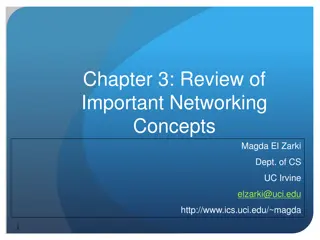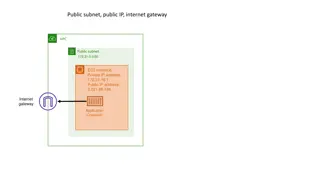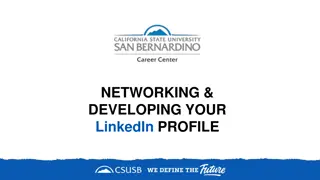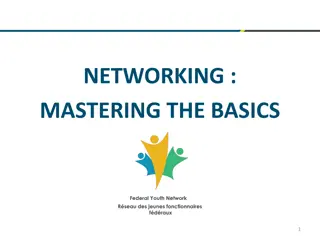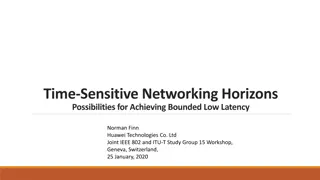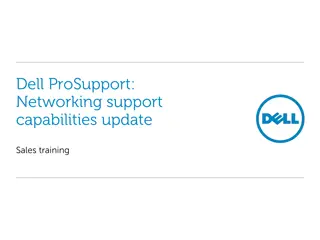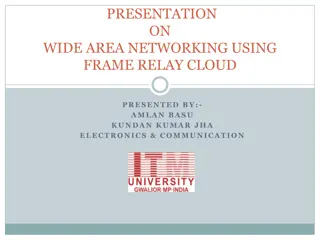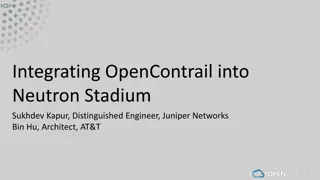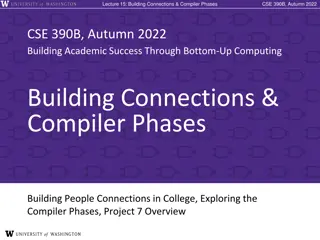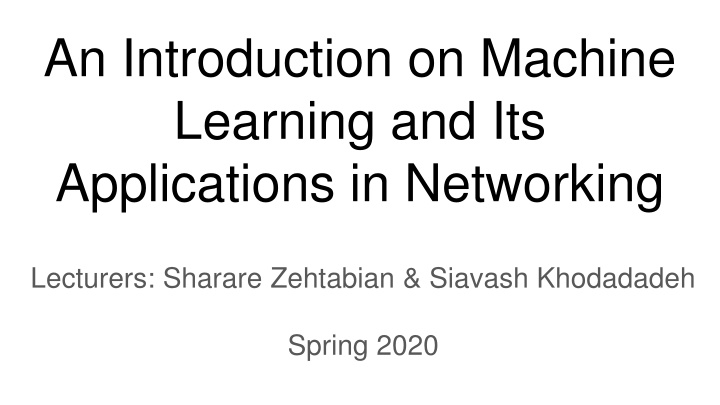
Introduction to Machine Learning and its Networking Applications
Explore the world of machine learning and its applications in networking, covering topics such as types of machine learning, supervised learning, unsupervised learning, reinforcement learning, neural networks, and deep learning. Discover the definition of machine learning, its importance in solving complex problems, and its practical applications in pattern recognition, anomaly detection, network optimization, and more.
Download Presentation

Please find below an Image/Link to download the presentation.
The content on the website is provided AS IS for your information and personal use only. It may not be sold, licensed, or shared on other websites without obtaining consent from the author. If you encounter any issues during the download, it is possible that the publisher has removed the file from their server.
You are allowed to download the files provided on this website for personal or commercial use, subject to the condition that they are used lawfully. All files are the property of their respective owners.
The content on the website is provided AS IS for your information and personal use only. It may not be sold, licensed, or shared on other websites without obtaining consent from the author.
E N D
Presentation Transcript
An Introduction on Machine Learning and Its Applications in Networking Lecturers: Sharare Zehtabian & Siavash Khodadadeh Spring 2020
Outline Machine learning Machine learning applications Types of machine learning Supervised learning setup classification regression Unsupervised learning Reinforcement learning Neural networks and deep learning
Machine learning definition Definition by Tom Mitchell (1998): Machine Learning is the study of algorithms that Improve their performance P At some tasks T With experience E A well-defined learning task is given by <P, T, E>.
Why machine learning? For many problems, it s difficult to program the correct behavior by hand Recognizing people and objects Understanding human speech Source: https://mc.ai/machine-learning-1100101b-lets-learn-about-learning/
Applications in networking Pattern recognition: Identifying patterns in networks traffic (e.g during a day or a week) Anomaly detection: Using AI to detect anomalies in the way applications are being accessed (e.g. outlier detection at Netflix using a clustering algorithm) Network optimization DeepMind AI reduced Google data centre cooling bill by 40% (PUE: Power Usage Effectiveness)
Applications in networking (contd) Forwarding path simplification Could ML find a better way CRUD (Create/Read/Update/Delete) operations in networking? Coordinating ML across edge and cloud Predictive caching Intent based networking: Intelligent automation and assurance Let s watch this video: Let's Talk Intent-based Networking and AI John Apostolopoulos and Anand Oswal explain how artificial intelligence can improve networks. Learn more at http://cs.co/6056EoEjp
Types of machine learning Supervised learning: have labeled examples of the correct behavior Unsupervised learning: no labeled examples instead, looking for interesting patterns in the data Reinforcement learning: learning system receives a reward signal, tries to learn to maximize the reward signal
Supervised learning setup We have a bunch of (x,y), where x Rdis the input instance and y is label Training dataset D={(x1,y1), ,(xn,yn)} Rd C Rdis the d-dimensional feature space xiis the input vector of the ith sample yiis the label of the ith sample C is the label space The training data pairs are drawn from some unknown distribution P
Supervised learning setup (contd) Try to predict properties of unseen data Given a new sample, can we predict its properties? Learning problem: Learn function h such that for a new pair (x, y) ~ P, we have h(x) y Example: You are given the data of 900 passengers on Titanic. (n = 900) For each passenger, we know some information like name, age, ticket number, cabin, etc We want to learn from this data if there is a correlation between these features (x) and whether the passenger survived the disaster (labels) Now we are given a new passenger s data and we want to predict whether he/she survives Label space? {survived, not survived}
Classification vs regression What can be our labels? Classification (discrete value) Binary classification (e.g. spam or not spam) Multi-class classification (e.g. dog or cat or horse or ..) Regression (continuous value e.g. price of a house) ref:https://scorecardstreet.wordpress.com/2015/12/09/is-machine-learning-the-new-epm-black/
Classification vs regression (examples) Classification example: Handwritten digit recognition Regression example: Prediction of the length of a salmon as a function of its age and weight. Length Weight
Other Classification Tasks Classification: given inputs x, predict labels (classes) y Examples: Spam detection (input: document, classes: spam / ham) OCR (input: images, classes: characters) Medical diagnosis (input: symptoms, classes: diseases) Automatic essay grading (input: document, classes: grades) Fraud detection (input: account activity, classes: fraud / no fraud) Customer service email routing many more Classification is an important commercial technology!
Training held-out and test data How can we evaluate our machine learning algorithm? Machine learning is about learning some properties of a data set (train) and then testing those properties against another data set (test). The test data set is used only for evaluation and you should not use it except for that. (Do not use this data set for making any decision about the model). Training Data Held-Out Data Test Data [This image is adapted from the ones created by Dan Klein and Pieter Abbeel for CS188 Intro to AI at UC Berkeley, available at http://ai.berkeley.edu.]
Supervised learning vs unsupervised learning Supervised learning: in which the data comes with additional attributes that we want to predict. classification regression Unsupervised learning: in which the training data consists of a set of input vectors x without any corresponding target values. clustering density estimation
More about unsupervised learning Why unsupervised learning is important? Labeling data costs time and resources 300 hours of video are uploaded to youtube every minute What are different approaches for it? Auto encoders Encode input to a latent space and reconstruct it from there Generative models Two agents (neural networks) play a min-max game against each other
Reinforcement learning Basic idea: Receive feedback in the form of rewards Agent s utility is defined by the reward function Must (learn to) act so as to maximize expected rewards All learning is based on observed samples of outcomes! Agent State: s Reward: r Actions: a Environment
Artificial neural networks History 1957 Perceptron (Frank Rosenblatt) 1969 Minsky & Papert (Perceptron book) (Funding for AI research collapsed) 1980s Machine learning emerges (Find patterns in data, bottom-up) 1980s Conferences for neural networks emerged 1990 (SVM) (No paper was accepted by conferences) 2006 (Geoffrey Hinton, Yunn LeCun, Yoshua Bengio) Rephrase neural networks to deep learning 2012 Imagenet-competition (Industry-wide artificial intelligence boom) Deep learning success Computational power: Data, GPUs Research: ReLU activations, Batch normalization, SGD Deep learning example https://playground.tensorflow.org/ https://en.wikipedia.org/wiki/ImageNet
Deep reinforcement learning Atari games Robot locomotion DeepMind: Emergence of locomotion behaviours in rich environments Congratulations, DeepMind DQN Breakout ? https://deepmind.com/blog/producing-flexible-behaviours-simulated-environments/ This video illustrates the improvement in the performance of DQN over training (i.e. after 100, 200, 400 and 600 episodes). After 600 episodes DQN finds and exploits the optimal strategy in this game, which is to make a tunnel around the side, and then allow the ball to hit blocks by bouncing behind the wall. Note: the score is displayed at the top left of the screen (maximum for clearing one screen is 448 points), number of lives remaining is shown in the middle (starting with 5 lives), and the 1 on the top right indicates this is a 1-player game.
Conclusion No free lunch theorem We can use different functions for our learning algorithm Decision tree Perceptron SVM Neural network etc We have to make assumption about the function which we use There is no single solution for all ML problems Deep learning is used in many different domains A function Hard to find the rules Can have a good amount of data



